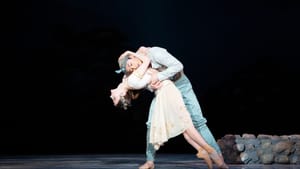Stay in the Loop
BSR publishes on a weekly schedule, with an email newsletter every Wednesday and Thursday morning. There’s no paywall, and subscribing is always free.
Here for the dancing
The Pennsylvania Ballet presents ‘La Bayadère’

La Bayadère, now running at the PA Ballet, gives us a love quadrangle set in a colonialist fairytale India signaled by a curtain with a caparisoned elephant on it. The Brahmin loves the temple dancer Nikiya, who loves the tiger-fighting warrior Solor, who betrays their avowals when the Rajah offers his daughter, Gamzatti, as a wife. It’s a classical ballet originally choreographed by Marius Petipa to the music of Ludwig Minkus, so I don’t have to tell you that by Act 2, Nikiya will be a ghost, along with a corps of ghostly shades in ahistorical white tutus.
We don’t expect trenchant storytelling, which is fortunate because the ballet has been so cut-and-pasted over the past 143 years that only the most rudimentary bits of story remain. We are here for the opulence and the dancing, and the PA Ballet delivers a dream performance.
The ballet opens in front of a temple almost swallowed by a jungle of tropical foliage (courtesy of the Boston Ballet). Temple dancers in floating blue skirts circle a fire pit while the men in brown loincloths—fakirs, the program tells us—scamper across the stage until they explode in glorious leaps. Angel Corella has cut a particularly cringe-worthy part of this dance, but work remains to highlight the brilliant sections of the male dancing in less questionable costumes.
Tragic love
Oksana Maslova is exquisite in the role of Nakiya. We feel for her when she rebuffs the advances of her boss, the Brahmin. She seems to float through the lyrical dance with the water jug as she awaits her romantic hero Solor, danced by Zechang Liang. Maslova and Liang lifted our hearts as they danced the innocence and sensuality of their love.
As Gamzatti, Mayara Pineiro gives us a striking contrast to the ethereal Nikiya in a performance both rich and assured. We expect technique from the principals, but I am always amazed at Piniero’s presence. She makes us believe that Gazmatti is a real woman, jealous in her passion. As Solor, Liang must adjust to each of his partners while embodying the different relationships, and he gives us a romance with Nikiya as delicate as butterfly wings. His more earthly chemistry with Gamzatti feels equally valid.
The bronze idol
The dance of the bronze idol, ably performed by Albert Gordon in not much more than paint, is one of the most famous variations for a male dancer in the repertoire, but Petipa didn’t choreograph it. Nikolai Zubkovsky did that in 1948, to Minkus’s music for a different ballet. The movement is more angular, faster, and has a characteristic twitch of the hip that reminds me of Nijinsky. It remains one of my favorite dances in the ballet, but it seemed more than usually disconnected from the action.
Act 1 ends with Nikiya’s murder at the engagement party of Gamzatti and Solor. Forced to perform as a temple dancer, she dances with a basket of flowers, unaware that a deadly snake lurks among the blossoms.

The Kingdom of the Shades
But really, we’ve all come for the Kingdom of the Shades, the most difficult ballet blanc in the repertoire. Act 1 gives us some lovely dancing, but it serves best by making us care when a distraught Solor escapes his grief and remorse in opium. In his dreams, spirits in white tutus with fluttering scarfs for sleeves appear from above: two steps, arabesque, two steps, pose, then again, moving down the incline as the next dancer appears at the top. The line of dancers snakes across the stage until they are arranged in a more familiar square formation. The difficulty is in the control: each movement is performed slowly, precisely, and in unison. When performed perfectly, as the corps did on opening night, the effect is hypnotically beautiful, as if we have followed Solor into his opium dream.
In the wistful dream pas de deux, Solor mourns on one knee, his eyes cast down. Behind him, Nakiya sets her hand on his shoulder in an arabesque that seems to enfold him. He turns, they dance. Corella’s ending nods to Romeo and Juliet or Swan Lake as Solor chooses to follow Nikiya into death.
Recognizing the problem
This review just hints at the larger controversies that surround La Bayadère. Communities increasingly demand that we face up to the history of colonialism that European artists of the 19th century turned into glittering fantasies for their wealthy patrons.
Ballet audiences haven’t changed that much—they still want the glitter and the romance. Neither the original music nor the dancing nor the love story of La Bayadère—and certainly not the ridiculous tray-table tutus that nevertheless make our hearts sing—are intrinsically Indian. Now that we recognize the problem, we need the will, and the understanding, to fix it.
Editor's note: you can find a petition about La Bayadère from local artist activists here.
What, When, Where
La Bayadère. Choreography by Marius Petipa. The Pennsylvania Ballet. Through March 15 at the Academy of Music, 240 South Broad Street, St. (215) 893-1999 or paballet.org.
The Academy of Music is a wheelchair-accessible venue. For more information about the accessibility of Kimmel campus venues, call Patron Services at (215) 893-1999 / (215) 875-7633 TTY or email [email protected]
Sign up for our newsletter
All of the week's new articles, all in one place. Sign up for the free weekly BSR newsletters, and don't miss a conversation.

 Camille Bacon-Smith
Camille Bacon-Smith